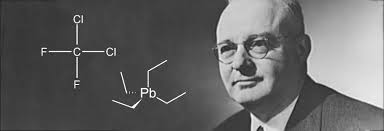American mechanical and chemical engineer Thomas Midgley was granted more than 100 patents over the course of this life, but he is best remembered for playing a major role in the development of leaded gasoline and chlorofluorocarbons.
Both products were later banned, of course.
CFC’s resulted in the deterioration of the ozone layer, eventually leading to their worldwide ban in 1987. A hole in the ozone layer remains over Antartica to this day.
Leaded gasoline was devastating to human beings and the environment, leading to widespread lead poisoning across the planet. Lead poisoning causes central nervous system damage and impairs neurological development in children. High atmospheric lead levels have been linked with serious long-term health problems from childhood, including neurological impairment, and with increased levels of violence and criminality in cities.
Elevated blood lead levels among children dropped from 88 percent in the years when leaded gasoline was still on the market to less than 1 percent in the post-phase out years.
So the next time you’re worried that you’re not leaving your mark on this world, consider Thomas Midgley. Environmental historian J. R. McNeill argued that Midgley “had more impact on the atmosphere than any other single organism in Earth’s history.”
Time magazine included both leaded gasoline and chlorofluorocarbons on its list of “The 50 Worst Inventions”
Sometimes it’s best to leave no mark behind.
Not being able to catch a break, Midgley contracted polio at age 51, which left him severely disabled. Being an inventor, he devised an elaborate system of ropes and pulleys to lift himself out of bed.
In 1944, he became entangled in the device and died of strangulation.
Not nearly as disastrous as leaded gasoline or chlorofluorocarbons, but another epically flawed invention nonetheless.









